
Hiking Around Las Vegas, Gold Butte National Monument

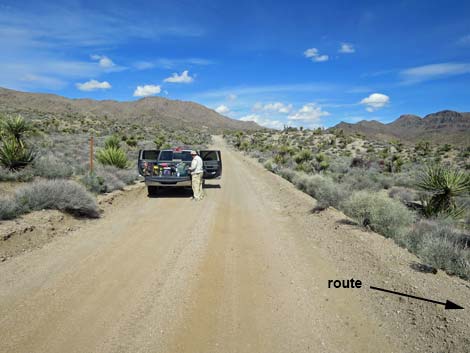 Trailhead parking on the edge of Devils Cove Road (view N) |
Overview Million Hills Wash is a nice 6.5-mile out-and-back hike in the wild and remote far southeast corner of Gold Butte National Monument. The hike starts from Devils Cove Road and cuts east all the way through the main backbone of Azure Ridge. There is no parking area and no trail. The route follows an old road that runs down to New Spring on the edge of the main canyon, which at this point is New Spring Canyon. The route then runs down the canyon, which jogs back and forth following erosion patterns through layers of ancient limestone. There are no true narrows, but the route runs through narrow sections with towering limestone cliffs and wider sections with grand views of colorful hills. The route passes a high pour-over, merges with Indian Trail Canyon to become Million Hills Canyon, passes another high pour-over, and finally emerges on the east side of Azure Ridge. Hikers have a variety of options at that point, but turning around and returning to the trailhead makes for a great day-hike. Remember, it is all uphill on the way out. Link to hiking map. |
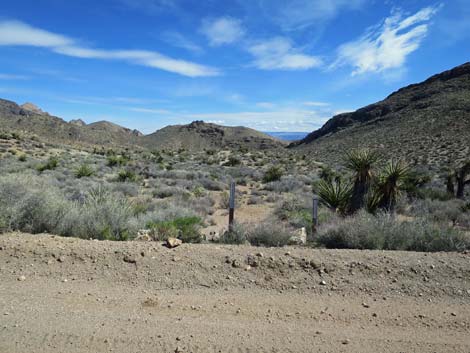 Trailhead on the edge of Devils Cove Road (view E) |
Watch Out Other than the standard warnings about hiking in the desert, ... this hike is fairly safe, but there are several water-polished pour-overs to bypass. Always be extra careful when high enough to fall and get hurt -- help is a long way away. This is wild and remote country without services of any kind (no restrooms, no water, no gas, no food, no cell service). Bring what you need to survive. Be prepared and be self-reliant. It is a big place, but someone will eventually find you if you stay on a main road, but be prepared to survive alone for a day or two, or even longer on side roads and trails. While hiking, please respect the land and the other people out there, and try to Leave No Trace of your passage. Also, this is a very remote hike, so be sure to bring the 10 Essentials. |
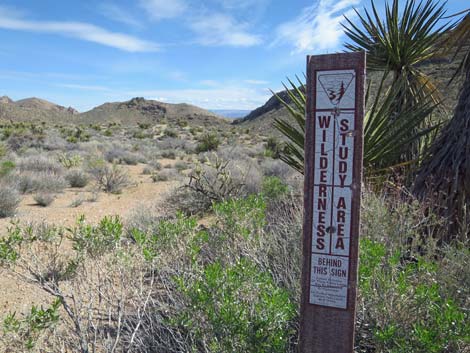 Million Hills Wilderness Study Area sign (view E) |
Getting to the Trailhead Million Hills Wash is located out in Gold Butte National Monument, about 3-1/2 to 4 hours northeast of Las Vegas in a wild, remote, and scenic area. From town, drive out to Gold Butte National Monument. From Whitney Pocket, continue south on the unpaved Gold Butte Road for 16.5 miles to a fork. Stay left onto Devils Cove Road and continue south, then east, then south again for 7.4 miles to the trailhead. These roads usually are suitable for carefully driven 2WD-HC vehicles. Approaching the trailhead area, watch for a green splash of color down a canyon to the left, which is New Spring. Continue a bit farther south watching on the left for a carsonite Million Hills Wilderness Study Area sign and an old, closed road. There is no off-road parking. Park on the edge of the roadway; this is the trailhead. |
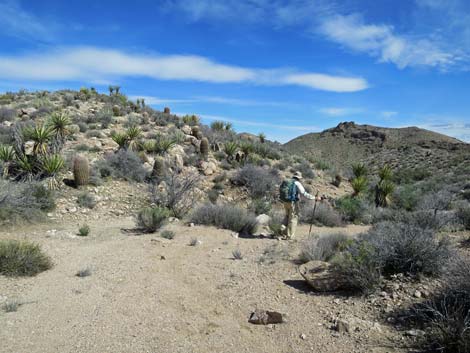 Hiker about 4 minutes into the hike (view NE) |
The Hike From the trailhead (Table 1, Waypoint 01), the route follows a closed road past a carsonite sign that announces entry into the Million Hills Wilderness Study Area. The old road proceeds generally downhill to the east. In about 5 minutes, hikers crest a low ridge and can see a patch of green in the canyon bottom about 0.2 miles distant, which is New Spring (Wpt. 04). The old road runs in and out of the wash and is fairly obvious and easy to follow, but note a fork in the wash (Wpt. 02) about 300 yards out where, on the return, it takes a moment or two to recall which way to go (stay right). The old road continues another 220 yards and drops into a larger wash (Wpt. 03). On the return, especially on a late return, the old road leaving the wash to the left is easy to miss. Note in this area the rounded granite boulders. These are ancient rocks on the order of 1.5-billion-years-old. By the time hikers get to New Spring, the rocks are limestone with ages of only about 0.5 billion years, at most. The granites here and to the west were in place long before the sedimentary limestone began to be laid down, so there must be a great unconformity along here somewhere. |
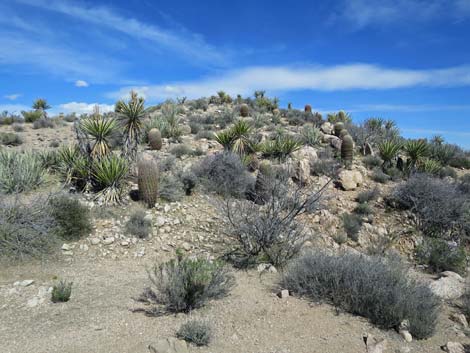 Nice cactus garden on the low hill (view N) |
In the larger wash, hikers can walk directly east about 250 yards to the Cottonwood Tree that marks New Spring. However, the heavy brush (mostly seep willow, Baccharis sarothroides) makes it difficult to watch for rattlesnakes underfoot, so it is safer to exit the wash to the left and walk along more open terrain until one can circle back into the spring (Wpt. 04) from below. The spring is dry, but the soils are damp. Just below New Spring, an old cement cattle watering trough sits in silent testament to the old days when rain fell, grass grew, and sheep and cows roamed this country. Just past New Spring, hikers drop into New Spring Wash, a large wash that runs down New Spring Canyon. For such a jumbled landscape, the canyon runs oddly straight south to a corner where it abruptly turns left to head northeast, then almost as abruptly bends right to run southeast, turns back to the east, and finally bends northwest! After this, the canyon winds in a manner that seems more appropriate for a jumbled landscape, but here the wash follows harder and softer layers of limestone as it cuts through Azure Ridge. |
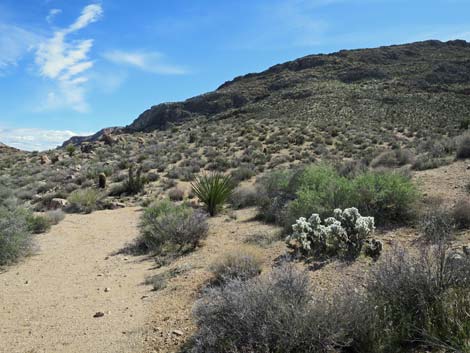 Most of the old road is obvious; note Blue Diamond Cholla (view E) |
At the end of the short northwest run, hikers arrive atop the first high pour-over (Wpt. 05). Bold hikers can tackle the polished rock directly, but for others, a bypass to the right climbs over a low ridge and drops down a steep, cobble-covered slope to the wash below. In this remote area, slips might be preferred to falls. Back in the wash, the canyon turns and winds generally northward, winds around to head more easterly, and eventually arrives at a confluence (Wpt. 06) with another major canyon that merges from the north. This is Indian Trail Canyon, but it is not at all clear why a trail would run that way. Beyond the confluence, the canyon becomes Million Hills Canyon. Continuing down Million Hills Wash in a generally easterly direction, the canyon eventually wraps hard to the left and bends back to the west. As the canyon turns back to the right, hikers arrive atop a low pour- over (Wpt. 07). This time, the pour-over is fairly easy to descend. Note the Ragged Rockflower (Crossosoma bigelovii) with the five, long white petals growing on the walls of the poor-over. This is the only place in Gold Butte where this plant is known to occur. |
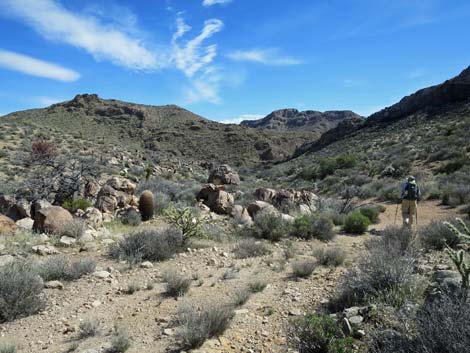 Hiker on old road; tree at New Spring becomes visible (view E) |
Winding down the canyon in generally a northeasterly direction, hikers eventually arrive at the second high pour-over (Wpt. 08). This one can also be bypassed, but it is not too bad of a down climb; hikers need to awkwardly slide under the side of the large chockstone. From there the canyon heads generally northeasterly again until bending back to a southeasterly direction. The canyon bends again to the east, runs through a fairly narrow section of canyon bottom where the walls are not high, and emerges onto a broad desert plain (Wpt. 09). The wash can be seen to cut through another small ridge to the east, and the Grand Wash Cliffs in Arizona can be seen in the far distance. The edge of the wash at this point (Wpt. 09) makes a nice place to stop for lunch. For most hikers, this is the point to turn around and return to the trailhead (Wpt. 01). Other hikers, however, might consider continuing down the wash and making a very long loop to the south that eventually returns to the trailhead. For those interested, review your map carefully and save some critical waypoints. |
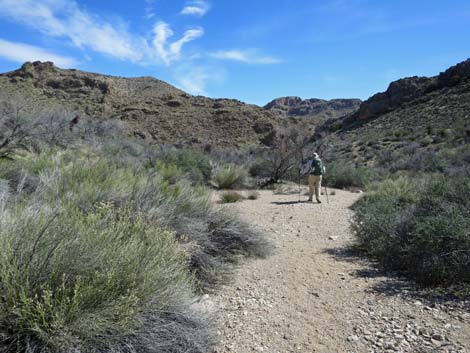 Merging into the larger wash (view E) |
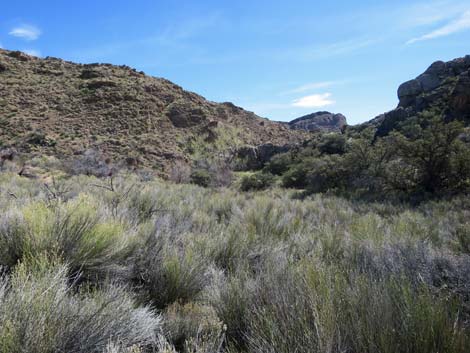 Wash bottom choked with shrubs (view E) |
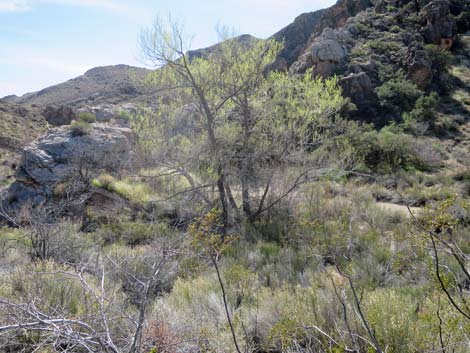 Hillside above the Cottonwood Tree (view SE) |
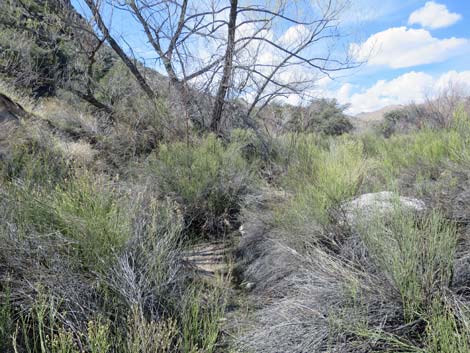 Approaching the Cottonwood from below (view W) |
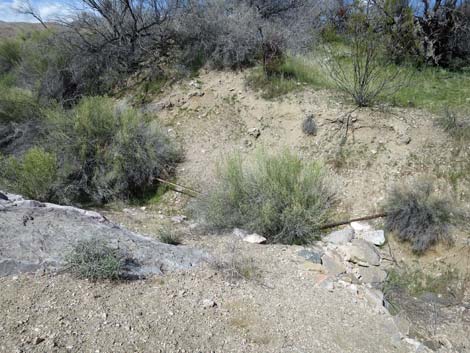 Exposed metal water pipe below New Spring |
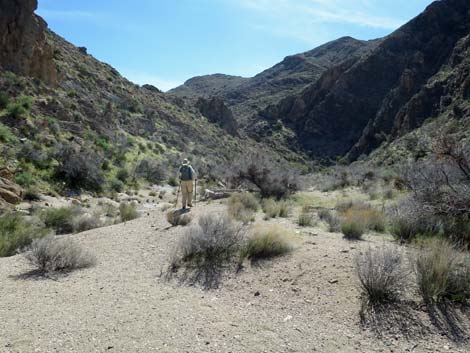 Hiker approaching old cement cattle watering trough (view SE) |
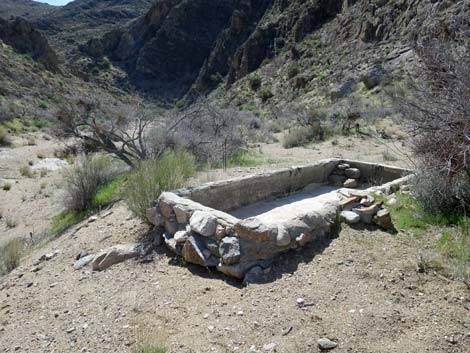 Old cement cattle watering trough (view SE) |
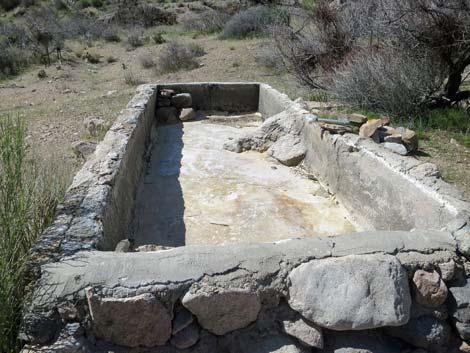 Old cement cattle watering trough (view S) |
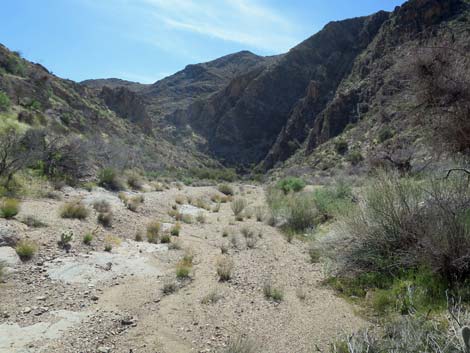 The route continues straight down New Spring Canyon (view S) |
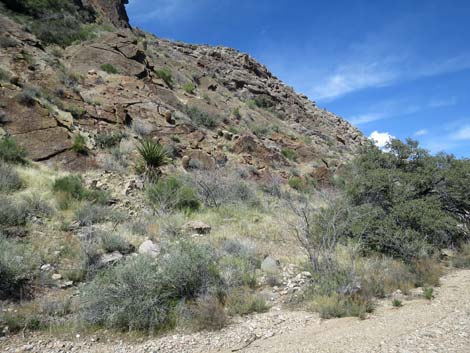 Limestone on the edge of the canyon (view SE) |
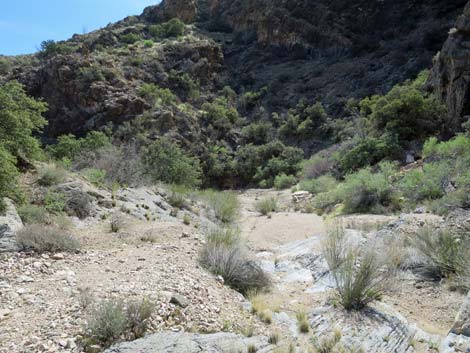 New Spring Wash takes a hard turn left (view S) |
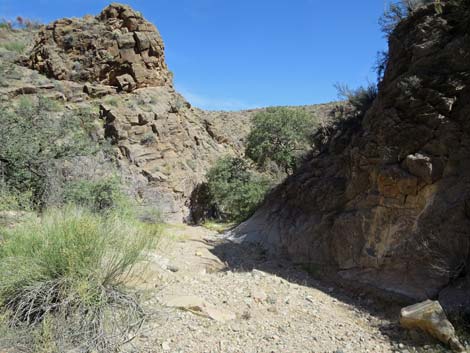 Just beyond the bend, a narrow section of canyon bottom (view NE) |
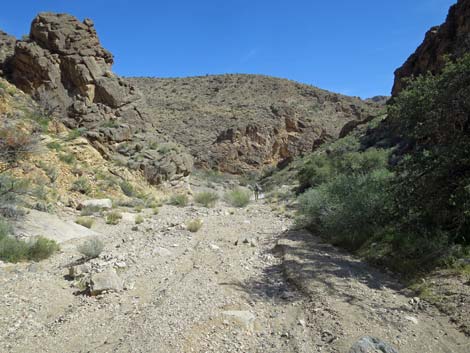 The canyon runs curiously straight again (view NE) |
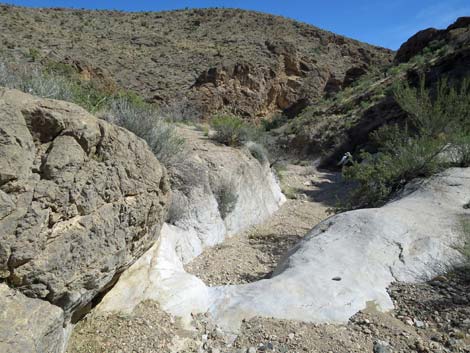 Polished limestone bedrock (view NE) |
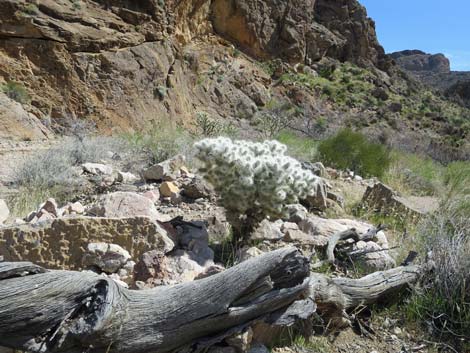 In the middle of the wash, the last Blue Diamond Cholla (view SE) |
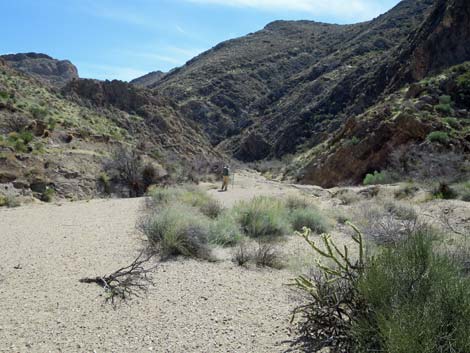 Another straight section of canyon (view SE) |
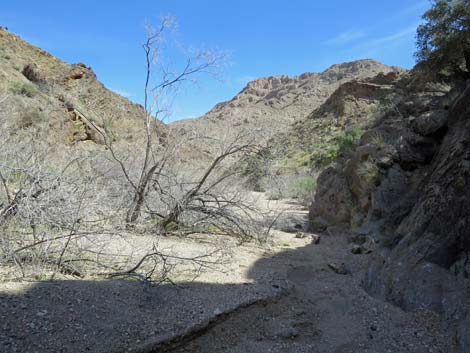 Welcome shade on a hot day (view NE) |
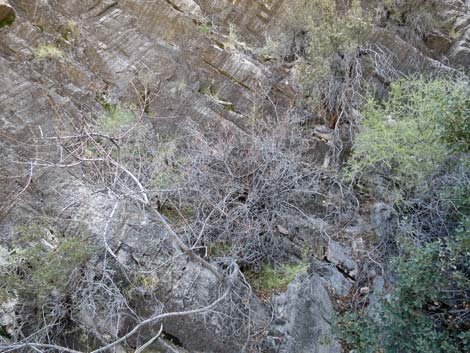 Interesting plants growing on a shady cliff face (view S) |
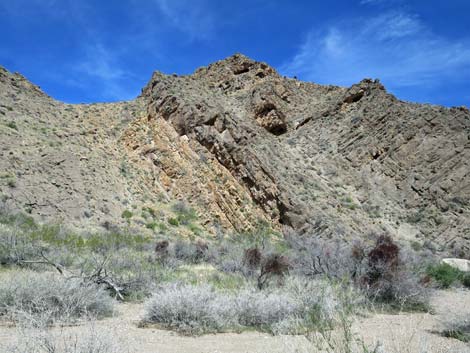 Nicely layered limestone (view E) |
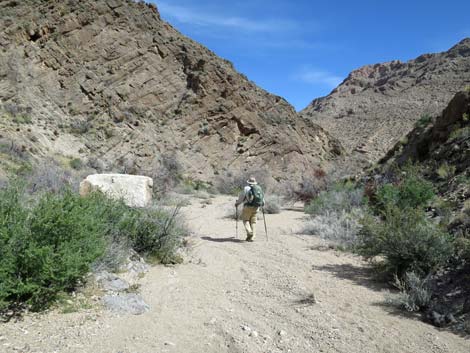 Hiker in sandy wash (view NE) |
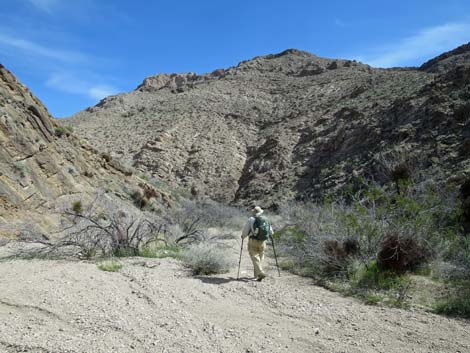 Easy hiking in sandy wash (view E) |
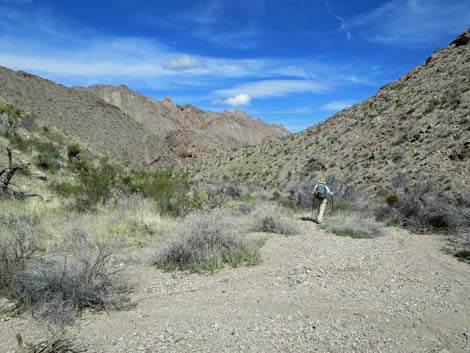 Easy hiking in sandy wash (view NE) |
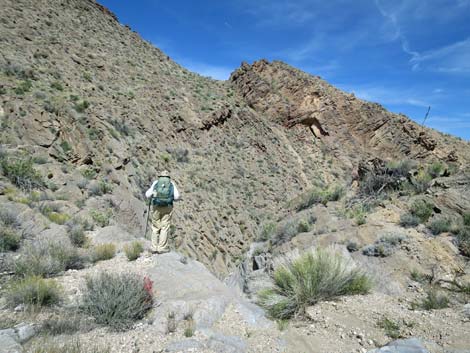 Hiker atop first high pour-over (view NE) |
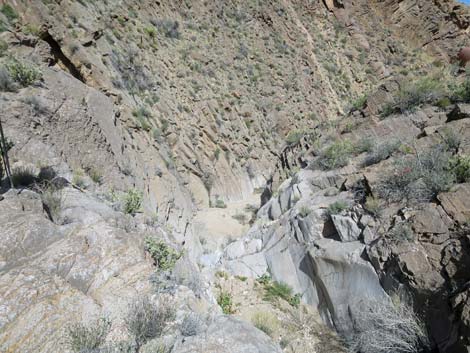 Looking down the high, 2-step pour-over (view NE) |
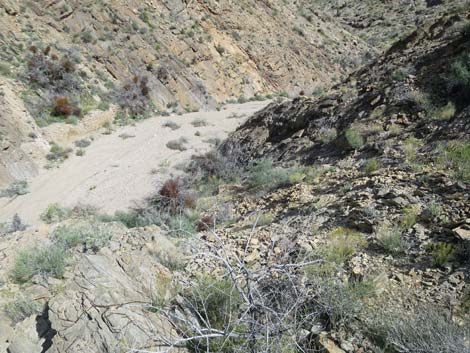 On south side, top of the bypass (view NE) |
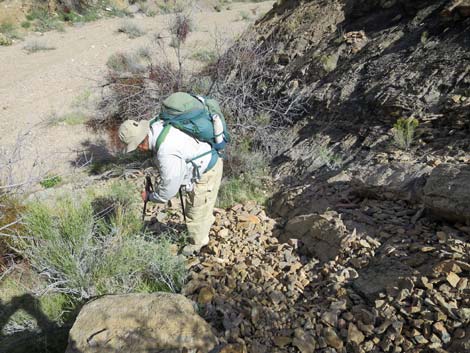 Hiker descending the bypass; lots of loose rocks (view NE) |
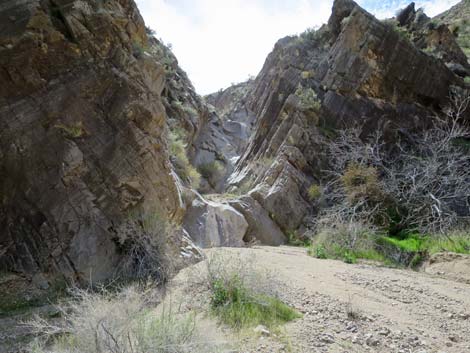 Looking back up at the pour-over (view SW) |
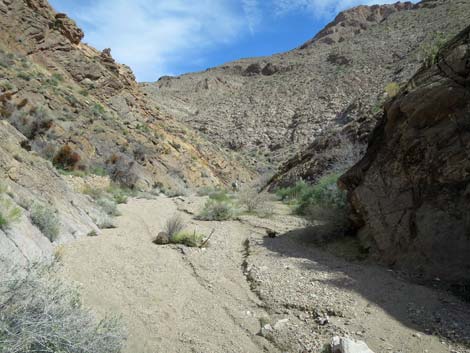 Base of pour-over, continuing down the wash (view NE) |
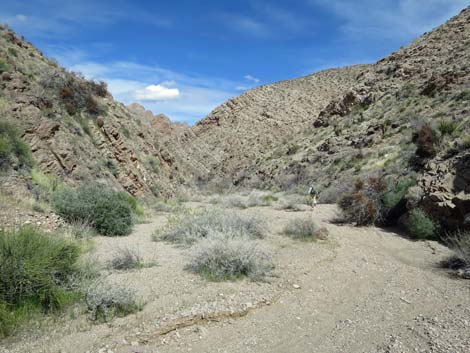 Hiker continuing down the wash (view N) |
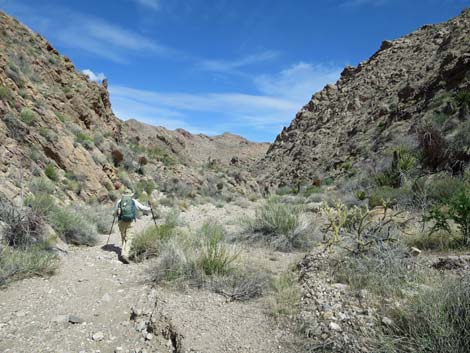 Hiker continuing down the wash (view NE) |
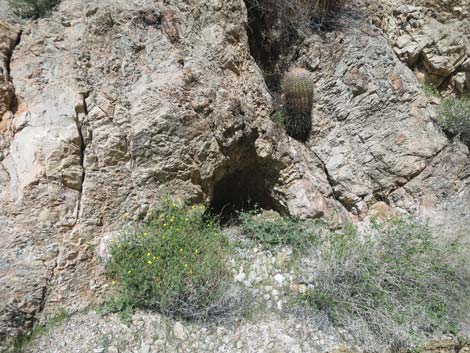 A place for monsters to hide? |
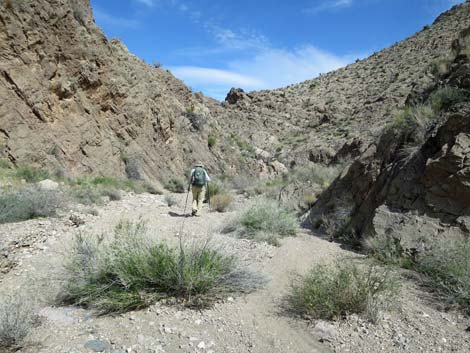 Hiker continuing down the wash (view NE) |
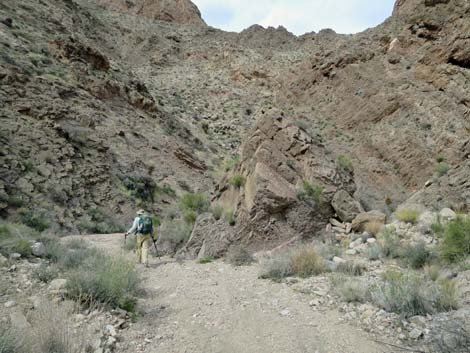 Wash narrows and bends left (view NW) |
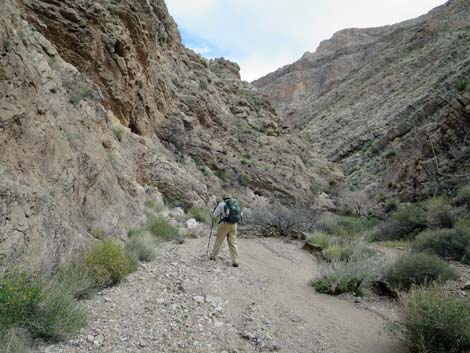 Hiker continuing down the narrow wash (view SE) |
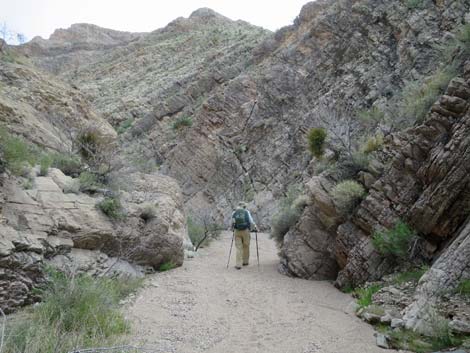 Hiker continuing down the narrow wash (view SE) |
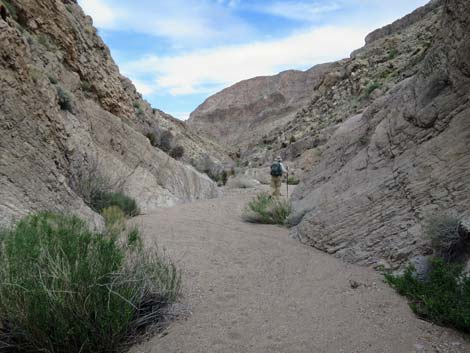 Hiker continuing down the narrow wash (view E) |
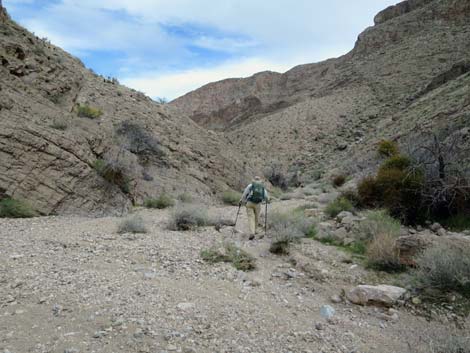 Hiker continuing down the wash (view E) |
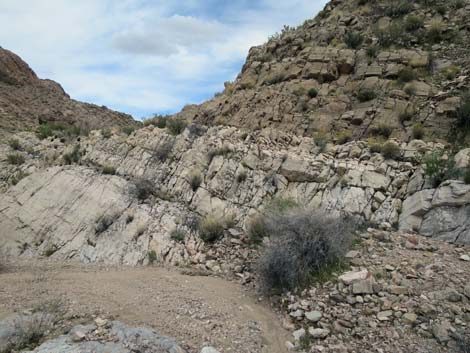 Interesting layers of limestone (view E) |
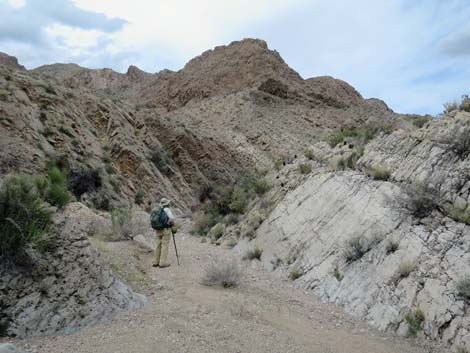 Interesting layers of limestone (view NE) |
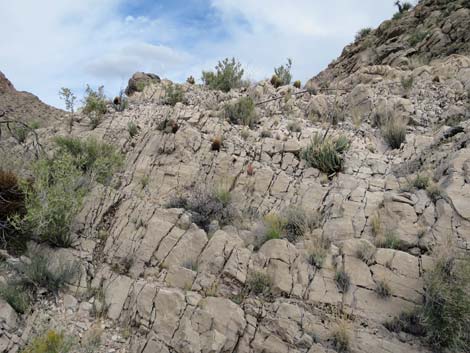 Another nice rock garden (view E) |
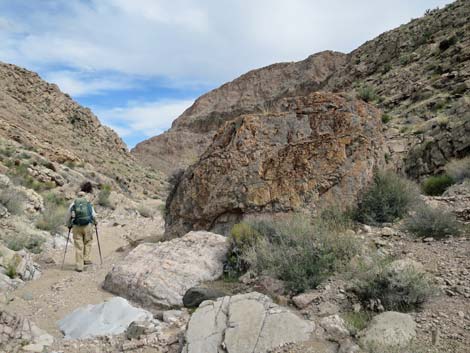 Hiker passing a fossil-filled boulder (view E) |
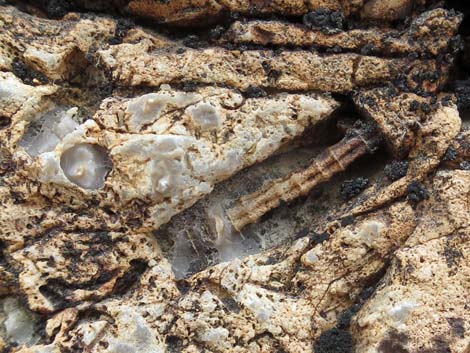 Exposed central stem cavity of a fossil Crinoid |
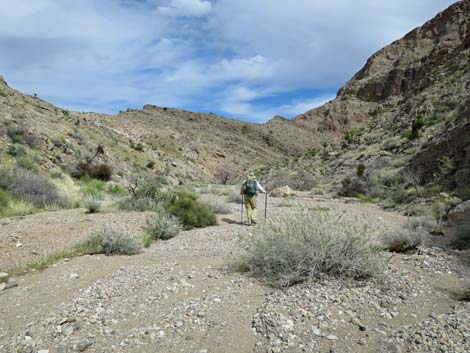 Hiker continuing down the wash (view NE) |
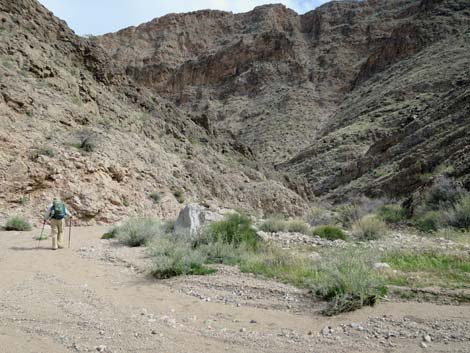 Hiker continuing down the wash (view SE) |
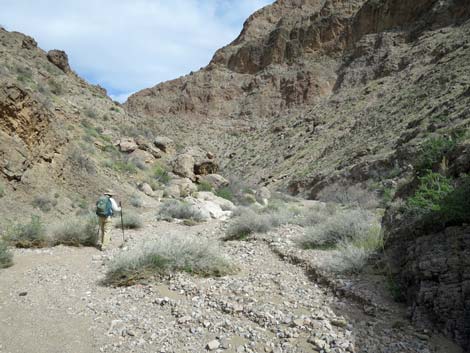 Canyon bottom narrows again (view E) |
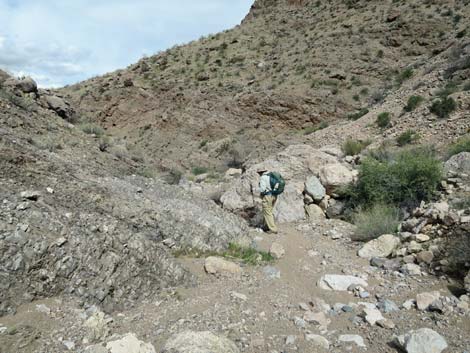 Another boulder in the wash (view NE) |
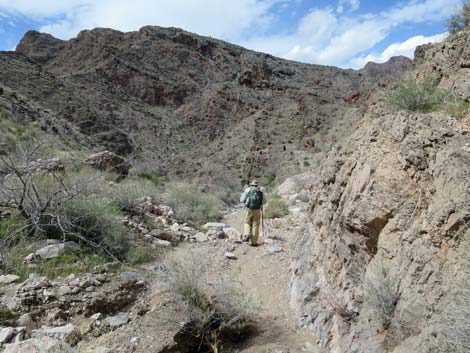 Hiker in narrow canyon bottom (view NW) |
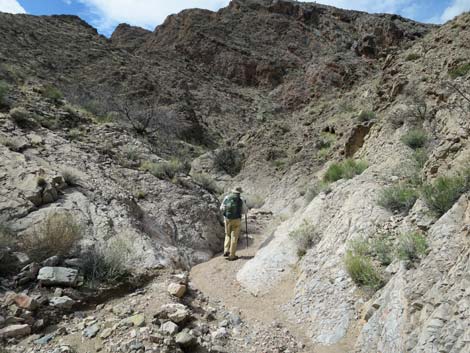 Hiker continuing in narrow canyon bottom (view W) |
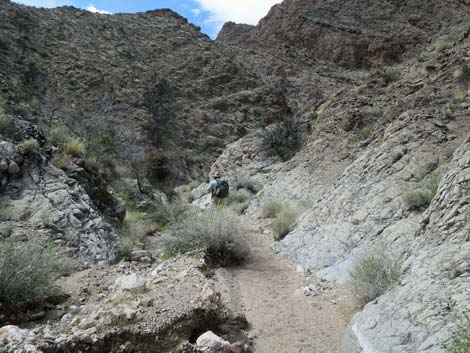 Hiker continuing in narrow canyon bottom (view W) |
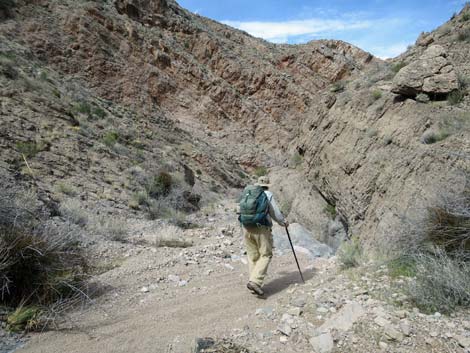 Hiker arriving atop a low pour-over (view N) |
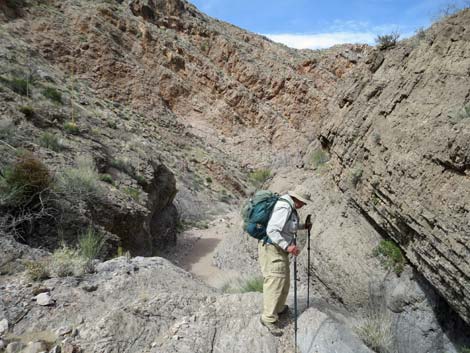 Hiker atop a low pour-over (view N) |
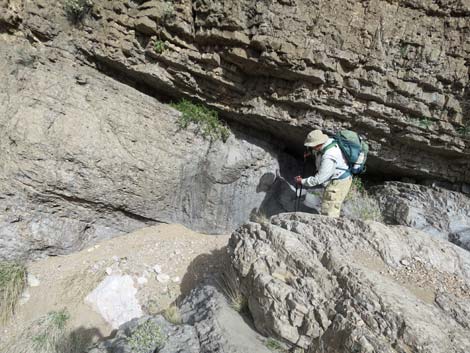 Hiker scrambling down the low pour-over (view E) |
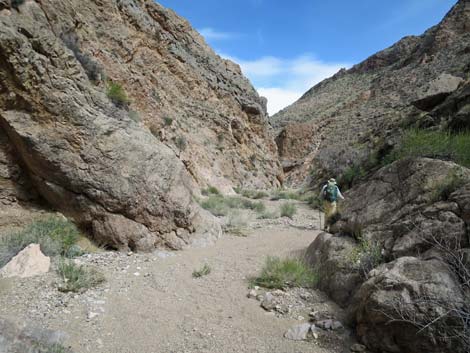 Hiker continuing below low pour-over (view E) |
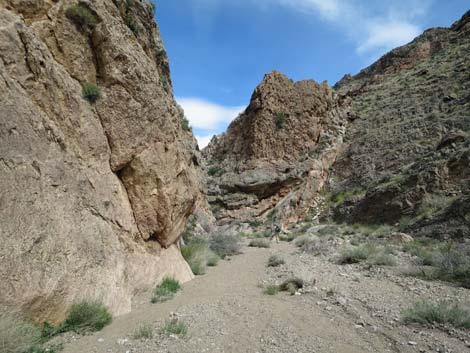 Nice canyon walls (view E) |
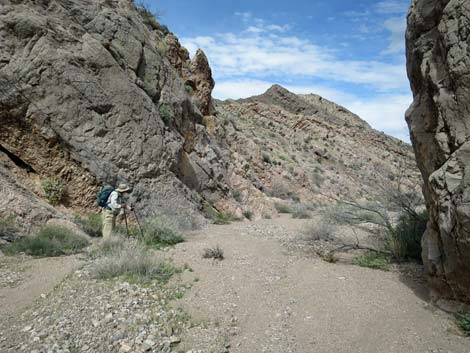 Canyon jogs north again (view NE) |
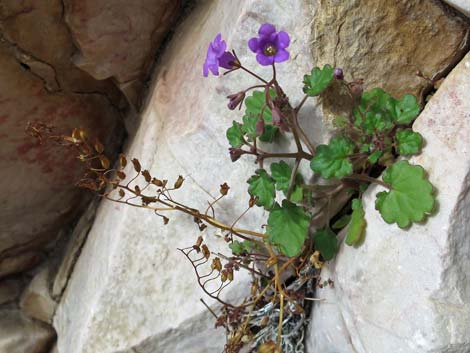 Beautiful Beautiful Phacelia |
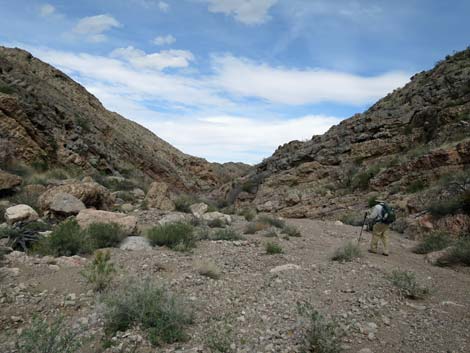 Canyon walls lay back (view NE) |
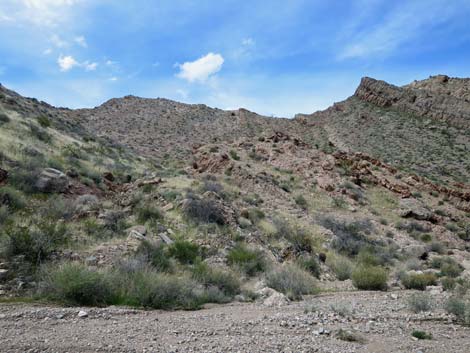 Ocotillo are visible on the ridgeline (view NW) |
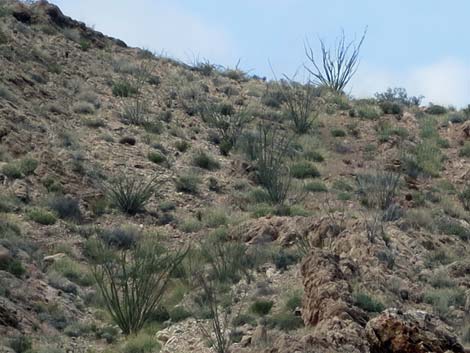 Ocotillo are visible on the ridgeline (view NW; zoom) |
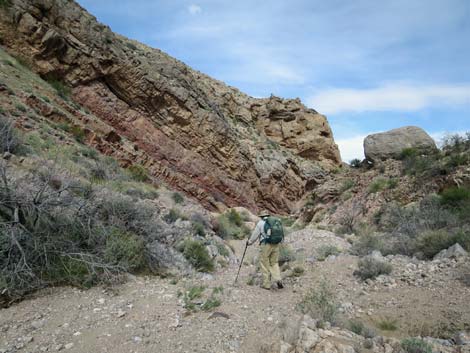 Colorful walls as the canyon narrows again (view NE) |
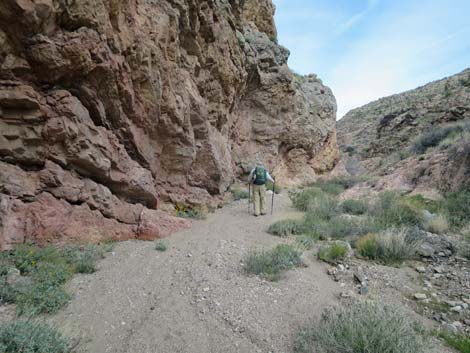 Hiker continuing past colorful rock walls (view NE) |
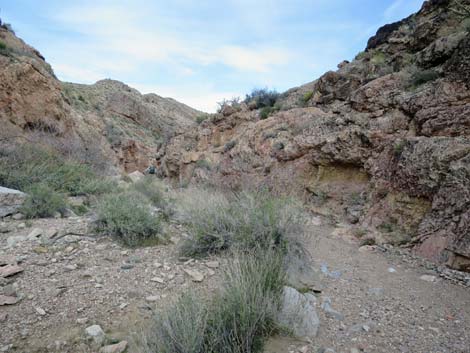 Approaching another pour-over (view NE) |
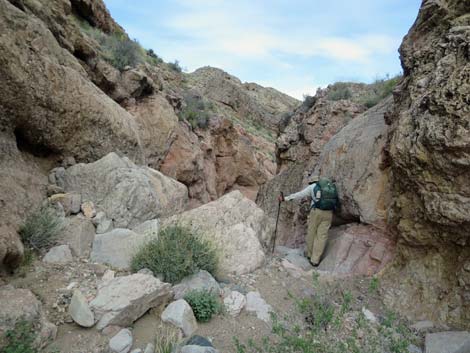 Hiker atop the second high pour-over (view NE) |
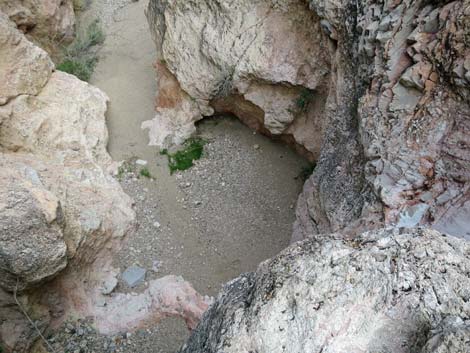 Pour-over; a little awkward but not too bad (view down) |
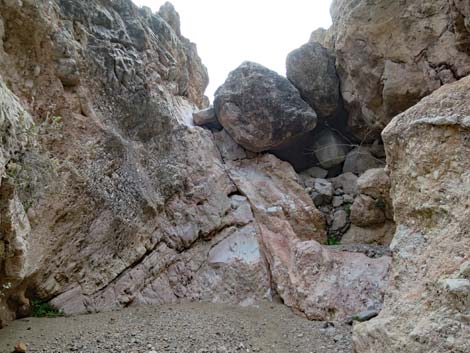 Looking back up at the pour-over (view SE) |
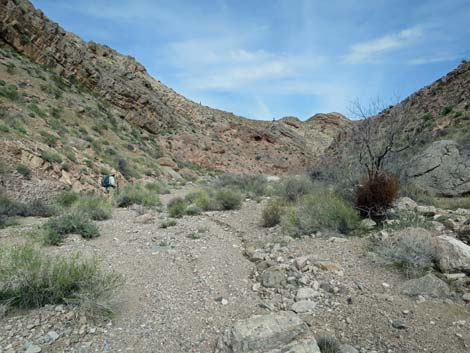 Hiker continuing down the canyon (view NE) |
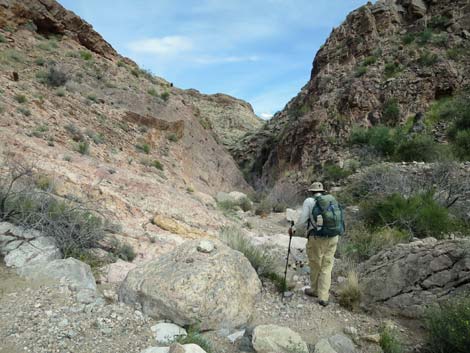 Hiker approaching the narrowest section of canyon bottom (view E) |
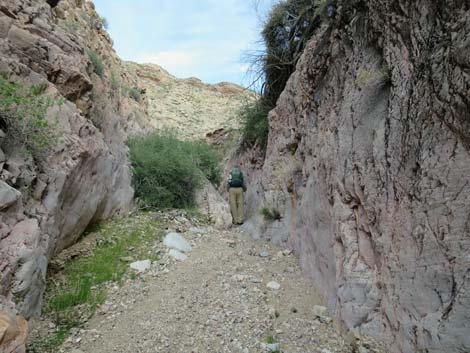 Hiker squeezing past a boulder in the narrows (view E) |
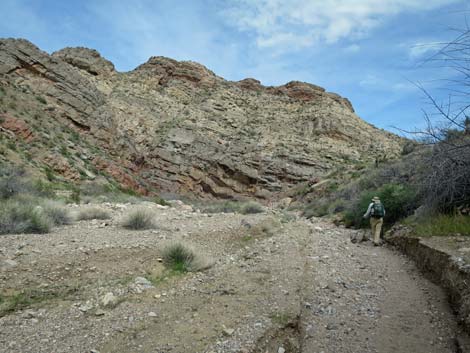 Hiker continuing down the canyon (view E) |
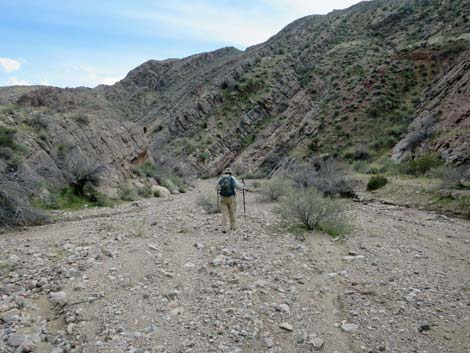 Hiker continuing down the canyon (view S) |
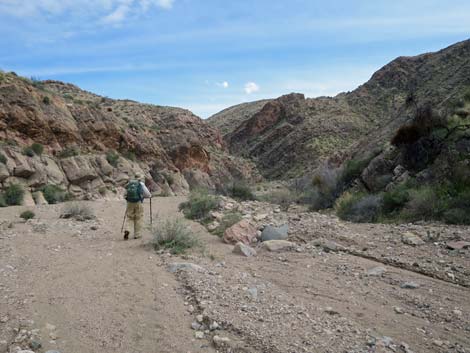 Hiker continuing down the canyon (view S) |
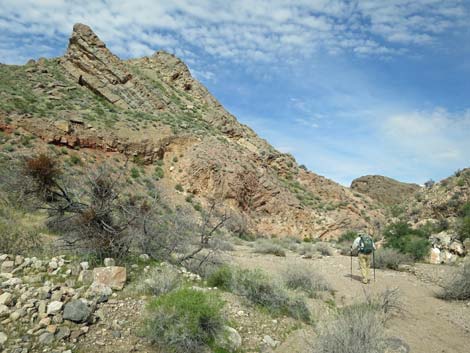 Hiker approaching the last narrow section of canyon (view NE) |
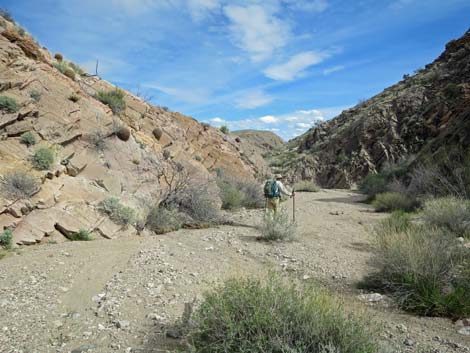 Hiker in the last narrow section of canyon (view SE) |
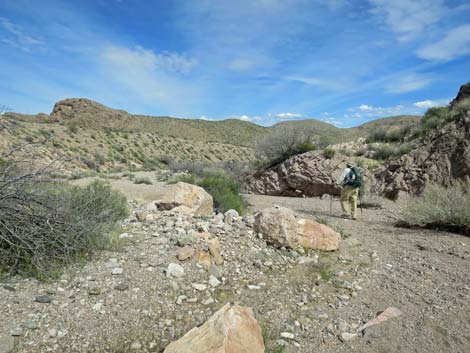 Hiker exiting the last narrow section of canyon (view NE) |
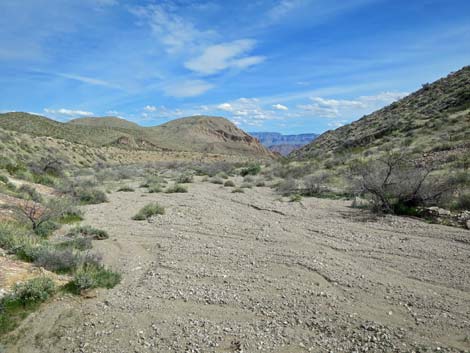 Broad, open desert below the last narrows (view SE) |
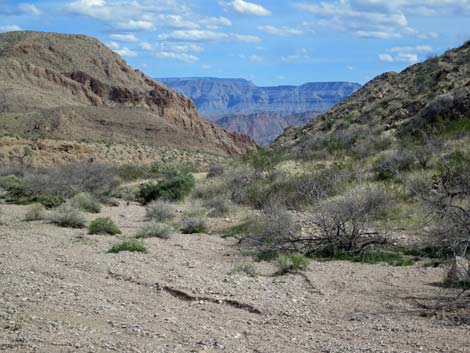 More narrows 0.8 miles out; Grand Wash Cliffs in distance (view SE) |
Table 1. Hiking Coordinates and Distances based on GPS Data (NAD27; UTM Zone 11S). Download Hiking GPS waypoints (gpx) file.
| Wpt. | Location | UTM Easting | UTM Northing | Elevation (ft) | Point-to-Point Distance (mi) | Cumulative Distance (mi) |
|---|---|---|---|---|---|---|
| 01 | Trailhead | 760283 | 4014749 | 3,442 | 0.00 | 0.00 |
| 02 | Fork in the Wash on Return | 760485 | 4014878 | 3,345 | 0.17 | 0.17 |
| 03 | Merge into Wash | 760619 | 4015002 | 3,292 | 0.13 | 0.30 |
| 04 | New Spring | 760869 | 4015021 | 3,283 | 0.23 | 0.53 |
| 05 | First High Pour-Over | 761445 | 4014990 | 3,033 | 0.74 | 1.27 |
| 06 | Confluence with Indian Trail Wash | 761955 | 4015528 | 2,842 | 0.75 | 2.02 |
| 07 | Low Pour-Over | 762196 | 4015684 | 2,818 | 0.37 | 2.39 |
| 08 | Second High Pour-Over | 762544 | 4016039 | 2,622 | 0.39 | 2.78 |
| 09 | End of Canyon | 763068 | 4015891 | 2,445 | 0.50 | 3.28 |
| 01 | Trailhead | 760283 | 4014749 | 3,442 | 3.28 | 6.56 |
Happy Hiking! All distances, elevations, and other facts are approximate.
![]() ; Last updated 240325
; Last updated 240325
| Hiking Around Gold Butte | Hiking Around Las Vegas | Glossary | Copyright, Conditions, Disclaimer | Home |